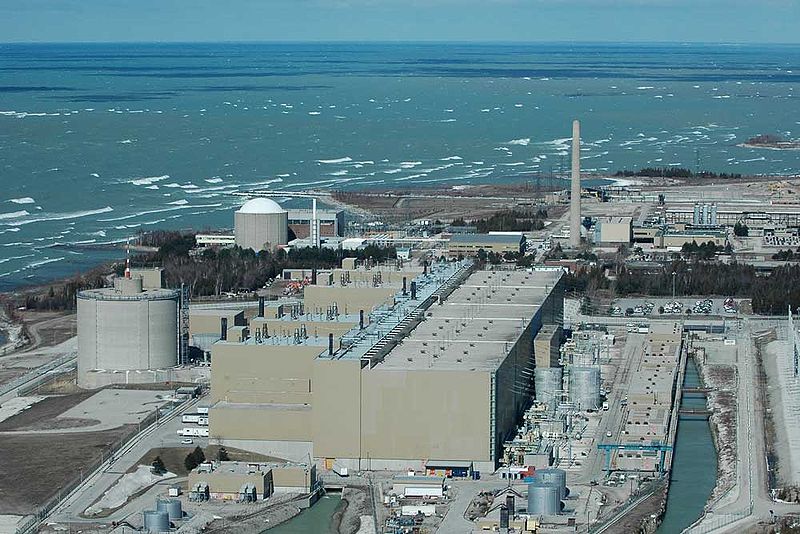Like this column? rabble is reader-supported journalism. Chip in to keep stories like these coming.
Ontario Power Generation’s (OPG) proposal to bury low- and intermediate-level radioactive waste from Ontario’s nuclear reactors in a deep cavern at the Bruce nuclear site on the shores of Lake Huron has hit a roadblock. On February 18, Environment Minister Catherine McKenna asked OPG for additional information, including alternative locations and updated analyses of cumulative effects and ways to mitigate adverse effects of the project.
This was a major victory for hundreds of municipal governments and citizens’ groups who questioned the wisdom of permanent disposal of nuclear waste immediately adjacent to the interconnected Lake Huron/Lake Michigan system, from which millions of people draw their drinking water.
According to a recent analysis by Lake Ontario Waterkeeper Mark Mattson, Minister McKenna’s action also represents an important step towards undoing the Harper government’s gutting of Canada’s environmental assessment legislation. A Harper government change had meant that a project proponent no longer had to examine “alternatives” to a project, only “alternative means” of carrying out a project on a chosen site.
Putting the brakes on OPG’s “deep geological repository” proposal may create some space for a broader consideration of Ontario’s commitment to nuclear power. Ontario Minister of Energy Bob Chiarelli recently announced that the Wynne government has given a green light to reactor “refurbishment” at the Bruce and Darlington nuclear complexes. Also part of these announcements was a delay in the scheduled closure of the Pickering reactors from 2020 to 2024, and a pushback of the start date to refurbish the Bruce reactors from 2016 to 2020.
Minister Chiarelli’s announcements will do little to alleviate concerns about the safety and costs of nuclear power. Greenpeace has repeatedly warned of the safety risks of running the aging Pickering and Darlington reactors, and of likely cost over-runs with Darlington refurbishment. The Ontario Clean Air Alliance will continue to urge the Wynne government to abandon refurbishment and import hydropower from Quebec. And in 2011, Mattson observed that “if we had a Fukushima disaster at one of Ontario’s 21 reactors, there would be no alternative potable drinking water.”
The “worst case scenario” for a nuclear accident was a major topic of debate during the recent Canadian Nuclear Safety Commission (CNSC) hearings on the relicensing of the Darlington reactor complex. A group of interveners led by the Canadian Environmental Law Association eventually forced the CNSC to release a Study of Consequences of a Hypothetical Severe Nuclear Accident and Effectiveness of Mitigation Measures. This study considers the possible need for evacuation of people living in a 12-km “primary zone” around reactors — less than the 20-km evacuation zone finally ordered by Japanese authorities around the Fukushima reactors.
After the hearings, the CNSC gave OPG a new 10-year licence and called for “annual regulatory oversight reports on the performance of the Darlington Nuclear Generating Station and on the status of the refurbishment project and emergency planning.”
Perhaps the CNSC’s most direct response to concerns about a severe nuclear accident in Ontario has been its 2014 directive to distribute potassium iodide pills to residents living within 10 km of reactors. These pills saturate the thyroid gland with non-radioactive iodine, thereby limiting risks of developing thyroid cancer following the uptake of radioactive iodine released during nuclear accidents. In the Fukushima region, 2,251 young people aged 19 years or less out of 298,577 screened developed thyroid cancer during the three-year period following the 2011 reactor accidents.
In addition to severe accident risks, the lack of socially and environmentally acceptable ways of dealing with waste continues to dog the nuclear industry. Minister McKenna’s request that OPG consider alternatives to its proposed geological repository for low- and intermediate-level wastes at the Bruce site could affect proposals for high-level nuclear fuel waste disposal. Costs of managing high-level wastes are a particular concern for OPG and other owners of Canada’s nuclear reactor fleet. CANDU reactors use unenriched uranium fuel and generate more than five times the high-level radioactive waste fuel rods of reactors using enriched fuel.
The Nuclear Waste Management Organization (NWMO), charged with finding a deep geological repository site for Canada’s high-level waste, has also been leading the development of OPG’s proposed repository at the Bruce site for low- and intermediate-level waste. Three NWMO candidate sites for high-level waste are located near the Bruce site.
Nuclear industry critics will continue to assert that the risks of nuclear power outweigh its benefits. They warn that the “true costs” of nuclear power remain uncertain, and cite evidence that nuclear power is already the major contributor to high electricity costs in Ontario. And they can now wait to see if the industry’s preferred waste disposal “solution” of deep geological repositories near existing nuclear sites can stand the test of a credible environmental assessment process.
Ole Hendrickson is a retired forest ecologist and a founding member of the Ottawa River Institute, a non-profit charitable organization based in the Ottawa Valley.
Photo of Bruce Nuclear Generating Station by Chuck Szmurlo/Wikimedia Commons
Like this column? rabble is reader-supported journalism. Chip in to keep stories like these coming.



